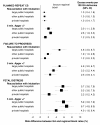Regional block versus general anaesthesia for caesarean section and neonatal outcomes: a population-based study
- PMID: 19402884
- PMCID: PMC2683867
- DOI: 10.1186/1741-7015-7-20
Regional block versus general anaesthesia for caesarean section and neonatal outcomes: a population-based study
Abstract
Background: Anaesthesia guidelines recommend regional anaesthesia for most caesarean sections due to the risk of failed intubation and aspiration with general anaesthesia. However, general anaesthesia is considered to be safe for the foetus, based on limited evidence, and is still used for caesarean sections.
Methods: Cohorts of caesarean sections by indication (that is, planned repeat caesarean section, failure to progress, foetal distress) were selected from the period 1998 to 2004 (N = 50,806). Deliveries performed under general anaesthesia were compared with those performed under spinal or epidural, for the outcomes of neonatal intubation and 5-minute Apgar (Apgar5) <7.
Results: The risk of adverse outcomes was increased for caesarean sections under general anaesthesia for all three indications and across all levels of hospital. The relative risks were largest for low-risk planned repeat caesarean deliveries: resuscitation with intubation relative risk was 12.8 (95% confidence interval 7.6, 21.7), and Apgar5 <7 relative risk was 13.4 (95% confidence interval 9.2, 19.4). The largest absolute increase in risk was for unplanned caesareans due to foetal distress: there were five extra intubations per 100 deliveries and six extra Apgar5 <7 per 100 deliveries.
Conclusion: The infants most affected by general anaesthesia were those already compromised in utero, as evidenced by foetal distress. The increased rate of adverse neonatal outcomes should be weighed up when general anaesthesia is under consideration.
Figures
References
-
- American Society of Anesthesiologists Task Force on Obstetric Anesthesia Practice guidelines for obstetric anesthesia: an updated report by the American Society of Anesthesiologists Task Force on Obstetric Anesthesia. Anesthesiology. 2007;106:843–863. doi: 10.1097/01.anes.0000264744.63275.10. - DOI - PubMed
-
- Bloom SL, Spong CY, Weiner SJ, Landon MB, Rouse DJ, Varner MW, Moawad AH, Caritis SN, Harper M, Wapner RJ, Sorokin Y, Miodovnik M, O'Sullivan MJ, Sibai B, Langer O, Gabbe SG. Complications of anesthesia for cesarean delivery. Obstet Gynecol. 2005;106:281–287. - PubMed
-
- Afolabi BB, Lesi FEA, Merah NA. Regional versus general anaesthesia for caesarean section. Cochrane Database Syst Rev. 2006:CD004350. - PubMed
Publication types
MeSH terms
LinkOut - more resources
Full Text Sources
Medical


